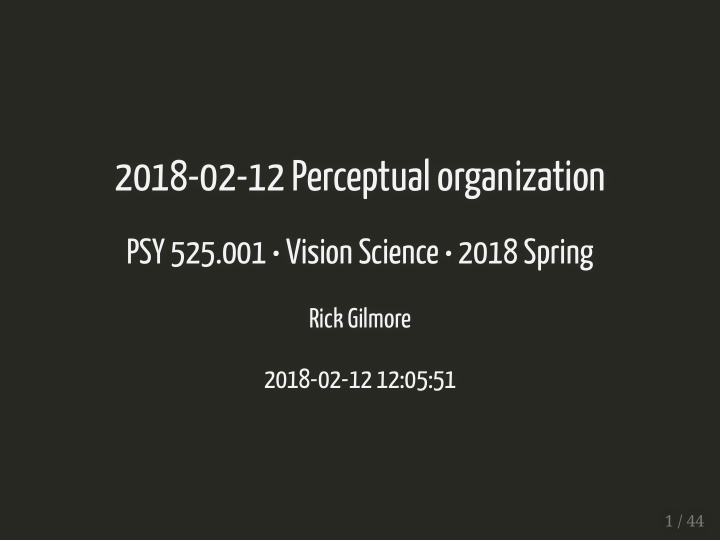



2018-02-12 Perceptual organization PSY 525.001 • Vision Science • 2018 Spring Rick Gilmore 2018-02-12 12:05:51 1 / 44
Today's topics 2 / 44
Today's topics Perceptual organization 2 / 44
Today's topics Perceptual organization Discuss Biederman (1987). 2 / 44
Perceptual grouping 3 / 44
Perceptual grouping 4 / 44
Element connectedness 5 / 44
Common region 6 / 44
Johansson: Motion Perception part 1 Motion and perceptual organization 7 / 44
Early or late? 8 / 44
Scene perception 9 / 44
Analyzing regions/camo�age 10 / 44
11 / 44
Uniform connectedness: region parsing before grouping? (Palmer & Rock) 12 / 44
13 / 44
Edge detection through spatial frequency �ltering 14 / 44
Illusory edges and spreading 15 / 44
Texture segregation 16 / 44
Ben-Shahar, O. (2006). Visual saliency and texture segregation without feature gradient. Proceedings of the National Academy of Sciences of the United States of America , 103 (42), 15704–15709. Retrieved from http://dx.doi.org/10.1073/pnas.0604410103 17 / 44
Figure/ground segregation 18 / 44
Figure Ground Thinglike Not thinglike Closer to observer Farther from observer Bounded by contour Extends behind contour Shape defined by contour No shape at contour Palmer Table 6.3.1 19 / 44
Symmetry, convexity, smallness, bottom-up polarity, lower region, protrusion 20 / 44
"Figure–ground segregation can be computed without relying on image contours. Figural status estimates result from a multidirectional linear voting process." Dimiccoli, M. (2016). Figure-ground segregation: A fully nonlocal approach. Vision Research , 126 , 308–317. Retrieved from http://dx.doi.org/10.1016/j.visres.2015.03.007 21 / 44
Amodal completion (perception of occluded whole) vs. modal completion (perception of unoccluded whole) 22 / 44
23 / 44
Ringach, D. L., & Shapley, R. (1996). Spatial and temporal properties of illusory contours and amodal boundary completion. Vision Research , 36 (19), 3037– 3050. Retrieved from https://www.ncbi.nlm.nih.gov/pubmed/8917767 24 / 44
Multi-stable images 25 / 44
Pitts, M. A., Nerger, J. L., & Davis, T. J. R. (2007). Electrophysiological correlates of perceptual reversals for three different types of multistable images. Journal of Vision , 7 (1), 6. Retrieved from http://dx.doi.org/10.1167/7.1.6 26 / 44
Necker cube with illusory contours 27 / 44
ambiguous and unambiguous plaid motion stimuli - Psychophysi… Ambiguous/multi-stable vs. unambiguous plaids 28 / 44
Are there deeper relationships at work here? 29 / 44
30 / 44
31 / 44
Geisler, W. S., & Perry, J. S. (2009). Contour statistics in natural images: Grouping across occlusions. Visual neuroscience, 26(1), 109–121. Cambridge University Press. 32 / 44
Geisler, W. S., & Perry, J. S. (2009). Contour statistics in natural images: Grouping across occlusions. Visual neuroscience, 26(1), 109–121. Cambridge University Press. 33 / 44
Geisler, W. S., & Perry, J. S. (2009). Contour statistics in natural images: Grouping across occlusions. Visual neuroscience, 26(1), 109–121. Cambridge University Press. 34 / 44
Break time 35 / 44
Discussion of Biederman (1987) 36 / 44
Principles of "non-accidentalness" 1. Collinearity 2. Curvilinearity 3. Symmetry 4. Parallel curves 5. Vertices 37 / 44
Brain Games Yellow Chair National Geographic Channel Watch o… Ames chair illusion illustrates implicit "principle" of co-termination 38 / 44
39 / 44
40 / 44
41 / 44
Edge Symmetry Size Axis Straight or Rot + Ref; Ref; Constant; Expanded; Expand Straight or Curved Asymm & Contract Curved 42 / 44
Next time... Size, shape, orientation, & position 43 / 44
Slides created via the R package xaringan . Rendered HTML and supporting files are pushed to GitHub where GitHub's 'pages' feature is used to host and serve the course website. 44 / 44
Recommend
More recommend